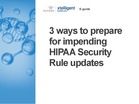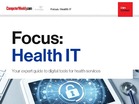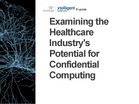Recognizing the trends in healthcare data breach lawsuits
By: XtelligentMedia Healthcare View more from XtelligentMedia Healthcare >>
Download this next:
3 ways to prepare for impending HIPAA Security Rule updates
By: XtelligentMedia Healthcare
Type: eGuide
In the decades since the HIPAA Security Rule was enacted, it has remained a crucial tool to covered entities and business associates as they navigate the multitude of cybersecurity risks that trouble the healthcare sector.
HIPAA’s flexible and scalable nature allows covered entities to implement the technical, physical, and administrative safeguards that are reasonable for each organization’s size and specific needs. However, as ransomware and data breaches continue to hit the healthcare sector, lawmakers and stakeholders in recent years have called to modernize elements of HIPAA to reflect the current health data security and privacy landscape.
These are also closely related to: "Recognizing the trends in healthcare data breach lawsuits"
-
Your expert guide to digital tools for health services
By: TechTarget ComputerWeekly.com
Type: eGuide
At a time when the NHS is faced with unprecedented pressure, new technological solutions can help ease some of the strain. From apps to electronic records and artificial intelligence, technology is playing an increasingly important part in transforming the health service. In this e-guide, we look at how digital tools can improve mental health services, both through sharing data and through mobile apps to help treat anxiety. We examine the use of virtual reality as a treatment tool and how the NHS can reap the benefits of artificial intelligence. We also look at the need for cyber security training and resilience in the health service following the recent WannaCry cyber attack.
-
Examining the Healthcare Industry's Potential for Confidential Computing
By: XtelligentMedia Healthcare
Type: eGuide
Healthcare data analytics requires some of the highest data privacy and protection measures across the industry, making implementing privacy-preserving technologies a top priority.
Doing so requires health systems to investigate, assess, and potentially deploy a variety of solutions.
Cloud adoption has become increasingly popular for securing healthcare data, but there are key technologies used within the context of cloud computing that can enhance data protection.
Find more content like what you just read:
-
What Part Does Clinical Informatics Play with the EHR?
By: XtelligentMedia Healthcare
Type: eGuide
EHR data can aid clinical informatics research through streamlined clinical trial recruitment, public health surveillance, and health IT analytics.
-
Healthcare companies secure 50% more sensitive data compared to the global average
By: XtelligentMedia Healthcare
Type: eGuide
The volume of sensitive data that healthcare organizations maintain makes ransomware attacks against these entities even more impactful.
-
Infographic: 10 high-value use cases for predictive analytics in healthcare
By: XtelligentMedia Healthcare
Type: Infographic
Predictive analytics can support population health management, financial success, and better outcomes across the value-based care continuum.
-
How Access to Care Is Affected by Inaccurate Provider Data from Payers
By: XtelligentMedia Healthcare
Type: eGuide
When payers' online provider information is wrong, it may impact not only members' access to care but also the level of member-payer trust.
-
Microsoft increases its analytics and AI capabilities in healthcare
By: XtelligentMedia Healthcare
Type: eGuide
New Microsoft Cloud for Healthcare offerings will focus on multimodal foundation models, data integration, healthcare agent services and nursing workflow improvements.
-
5 challenges to EHR implementation and solutions overcoming them
By: XtelligentMedia Healthcare
Type: eGuide
EHR implementation is no small feat, but being aware of common challenges can help prepare healthcare organizations for successful health IT deployments.
-
14% of Americans are responsible for 75% of the country's medical debt
By: XtelligentMedia Healthcare
Type: eGuide
Certain populations bear the brunt of the nation's medical debt burden, even as leaders work to relieve debt and remove it from credit reports.
-
Top IT challenges for healthcare organizations in rural areas
By: XtelligentMedia Healthcare
Type: eGuide
Rural healthcare providers have long faced challenges surrounding their geographical isolation and limited financial resources. However, the digital health transformation has ushered in a new set of rural health IT challenges.
-
How doctors can create patient trust through the use of generative AI
By: XtelligentMedia Healthcare
Type: eGuide
Providers and community health partners might be instrumental in building patient trust in generative AI and encouraging use.
-
Increasing mammography use to reduce the death rate from breast cancer
By: XtelligentMedia Healthcare
Type: eGuide
According to a CDC report, mammography utilization decreases with adverse social determinants of health.
-
How DirectTrust is Improving the Usability and Interoperability of Health Data
By: XtelligentMedia Healthcare
Type: eGuide
DirectTrust is looking to improve the usability of the Direct standard for use cases such as closed-loop referrals and ADT notifications to drive health data interoperability.
-
How DirectTrust is Improving the Usability and Interoperability of Health Data
By: XtelligentMedia Healthcare
Type: eGuide
DirectTrust is looking to improve the usability of the Direct standard for use cases such as closed-loop referrals and ADT notifications to drive health data interoperability.
-
How do Medicare Advantage providers create health plans tailored to a particular population?
By: XtelligentMedia Healthcare
Type: eGuide
Medicare Advantage insurers should prioritize data collection and provider collaboration when establishing population-specific health plans.
-
Using Analytic Tools to Improve Wildfire Victim Care Coordination
By: XtelligentMedia Healthcare
Type: eGuide
Analytics-driven population health management strategies may help healthcare organizations tackle the persistent care challenges posed by wildfires.
-
Payers Adopt Healthcare IT for Member Engagement and Cost Optimization
By: XtelligentMedia Healthcare
Type: eGuide
Payers expect to increase their spending on healthcare IT resources by 3 to 5 percent in the next two years.
-
Women are underrepresented in medical device clinical trials
By: XtelligentMedia Healthcare
Type: eGuide
A research letter published in JAMA Internal Medicine found that medical device clinical trials had a median female participant rate of 33%.
-
Three Crucial Metrics Determine Health Plans' Member Satisfaction
By: XtelligentMedia Healthcare
Type: eGuide
Nearly every payer in the survey was stumped by two factors of member satisfaction: digital customer experience and provider wait times.
-
How a Rural Hospital Is Maintained Through a GoFundMe Page
By: XtelligentMedia Healthcare
Type: eGuide
A GoFundMe page for a rural hospital in PA is not only supporting local access to care but also raising awareness about the financial troubles of rural healthcare.
-
Techniques for advancing value-based care in the face of an impending health crisis
By: XtelligentMedia Healthcare
Type: ESG
Centering provider and member experience will be key to accelerating value-based care in the coming years.
-
FDA warns the public about lead levels in cinnamon
By: XtelligentMedia Healthcare
Type: eGuide
The FDA has issued a warning to retailers and consumers regarding elevated lead levels in ground cinnamon.
-
How AI could reduce the amount of paperwork in nursing
By: XtelligentMedia Healthcare
Type: eGuide
As nurses face increasing levels of burnout, researchers are exploring how large language models could streamline clinical documentation and care planning.
-
How Revenue Cycle Management Is Optimized by Robotic Process Automation
By: XtelligentMedia Healthcare
Type: eGuide
Robotic process automation (RPA) saves practices money and time by automating manual, repetitive tasks within revenue cycle management.
-
Businesses find it difficult to gain business value from GenAI
By: XtelligentMedia Healthcare
Type: eGuide
Enterprises chase an impractical immediate payback from GenAI and miss opportunities to use less expensive machine learning to solve problems, experts say.
-
Four valuable applications of synthetic data in healthcare
By: XtelligentMedia Healthcare
Type: eGuide
Synthetic data generation and use can bolster clinical research, application development and data privacy protection efforts in the healthcare sector.
-
The majority of small practices claim that primary health IT providers are inadequate
By: XtelligentMedia Healthcare
Type: eGuide
According to a KLAS report, many small practices report that their core health IT vendors lack key functionalities beyond EHR and practice management, including telehealth.
-
Nine best practices for an effective EHR implementation
By: XtelligentMedia Healthcare
Type: eGuide
Successful EHR implementation requires meticulous planning, strong communication and effective training to navigate complexities and ensure a smooth transition.
-
Outlining 11 typical types of medical mistakes and patient harms
By: XtelligentMedia Healthcare
Type: eGuide
Understanding the most common types of medical errors might help tailor patient safety best practices.
-
Exploring emerging breast cancer screening technology
By: XtelligentMedia Healthcare
Type: eGuide
New breast cancer screening tools, ranging from 3D mammography to AI-assisted screening analysis play a critical role in the evolving breast cancer screening landscape.
-
Wearable AI technology assists in identifying medication errors
By: XtelligentMedia Healthcare
Type: eGuide
A wearable, deep learning-driven camera could help healthcare providers proactively identify potential errors prior to medication delivery with 99% accuracy.
-
Top data analytics tools for managing chronic disease
By: XtelligentMedia Healthcare
Type: eGuide
Effective chronic disease management requires healthcare stakeholders to effectively utilize data, population health management systems and predictive analytics tools.
-
How generative AI is reducing administrative burden in healthcare
By: XtelligentMedia Healthcare
Type: eGuide
Over 90% of healthcare workers feel optimistic about the promise of generative AI in healthcare to alleviate administrative burdens, according to a new survey.
-
A digital tool for patient engagement reduces childhood obesity
By: XtelligentMedia Healthcare
Type: eGuide
The digital patient engagement tool reduced early childhood obesity prevalence among kids at the highest end of BMI scales.
-
Which Health Plans Can Be Accessed by Individuals with Disabilities?
By: XtelligentMedia Healthcare
Type: eGuide
Medicare and Medicaid are common health plan options for people with disabilities, though they must meet certain criteria before becoming eligible for coverage.
-
Recognizing lawsuits against manufacturers of pharmaceuticals and medical devices
By: XtelligentMedia Healthcare
Type: eGuide
Understanding the surge in litigation against drug and medical device manufacturers is crucial for navigating legal complexities and ensuring patient safety.
-
A culture of belonging is essential in the fight for diversity in the medical industry
By: XtelligentMedia Healthcare
Type: eGuide
Better hiring practices, open discourse, and accountability will support a culture of belonging and allow for workforce diversity.
-
How Can Providers Create Successful Organizations for Accountable Care?
By: XtelligentMedia Healthcare
Type: eGuide
Providers must be prepared to address patient needs across the care continuum and be equipped with proper capabilities before joining or establishing an accountable care organization.
-
How Pharmacy Benefit Managers and Payers Collaborate to Reduce Costs
By: XtelligentMedia Healthcare
Type: Editorial Resource Guide
Pharmacy benefit managers negotiate prescription drug prices with drug manufacturers and pharmacies on behalf of payers.
-
Pharmacometabolomic data application for customized medicine
By: XtelligentMedia Healthcare
Type: eGuide
Pharmacometabolomics can provide additional context for personalized medicine by offering insights beyond genetic data.
-
Examining the Increase in Early-Onset Stomach Cancer
By: XtelligentMedia Healthcare
Type: eGuide
The uptick in stomach cancer cases in individuals under 50 challenges conventional cancer trends, stressing the need for deeper research and understanding.
-
The CDC is looking into how microneedling facials can spread HIV.
By: XtelligentMedia Healthcare
Type: eGuide
An MMWR from the CDC identified individuals who contracted HIV through cosmetic needles after microneedling facials at a New Mexico spa.
-
What do shared decision-making tools for patients mean?
By: XtelligentMedia Healthcare
Type: eGuide
Patient decision aids (PDAs) are key tools to help support patient education during the shared decision-making process.
-
How Case Western is Giving Medical Students' Training in Epic EHR Priority
By: XtelligentMedia Healthcare
Type: eGuide
Case Western Reserve University School of Medicine is the first medical school to leverage Lyceum, an Epic EHR training platform designed for first-year medical students.
-
Project of the Year and Healthcare Winner: StratMed
By: TechTarget ComputerWeekly.com
Type: eBook
Named Project of the Year in the Computer Weekly Innovation Awards APAC 2022, StratMed's Integer platform is facilitating data exchanges between healthcare providers and their suppliers to improve transparency in India's healthcare supply chain.
-
Pharmacometabomic data application for customized medicine
By: XtelligentMedia Healthcare
Type: eGuide
Pharmacometabolomics can provide additional context for personalized medicine by offering insights beyond genetic data.
-
Computer Weekly 16 July 2019: Reaping the benefits of digital transformation at Defra
By: TechTarget ComputerWeekly.com
Type: Ezine
In this week's Computer Weekly, we check out the digital transformation at Defra, and see how the government department is preparing for Brexit. The new technology chief for the NHS explains how he's going to bring the health service into the digital age. And we examine how to make a success of enterprise social media platforms. Read the issue now.
-
Top tech stories of 2024: India (Part 1)
By: TechTarget ComputerWeekly.com
Type: eGuide
India embraced AI in 2024, developing its own large language models, boosting supercomputing capabilities and applying the technology across sectors from healthcare to governance. In this round-up, we recap some of the key developments that kept chief information officers and technology suppliers across the subcontinent busy throughout the year.
-
Big data analytics & innovation in Australian healthcare
By: TechTarget ComputerWeekly.com
Type: eGuide
In this e-guide, find out how healthcare providers in Australia and the rest of APAC have successfully tapped the power of data analytics and other related technologies to advance digital health and better position themselves to cope with the growing demand for healthcare.



